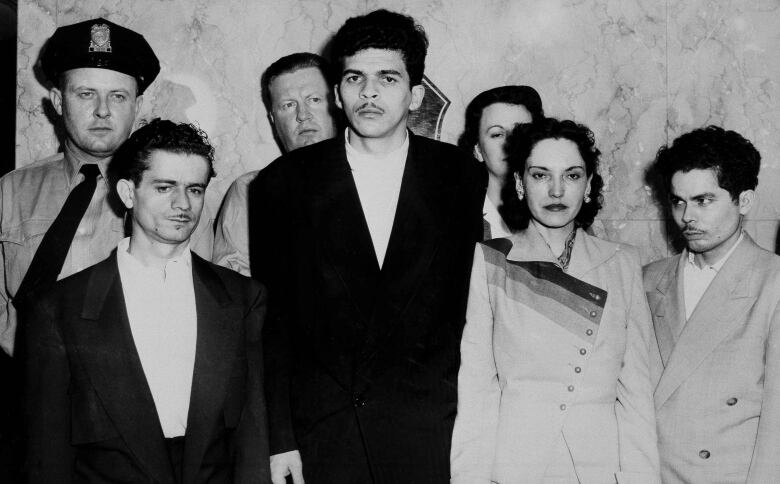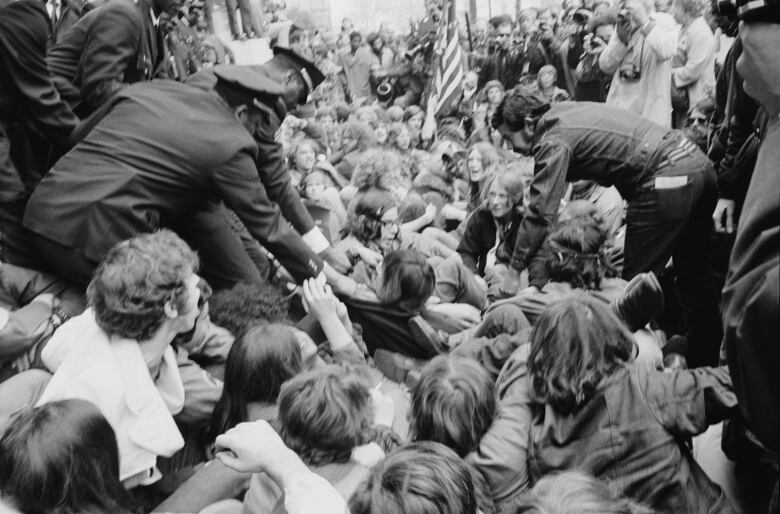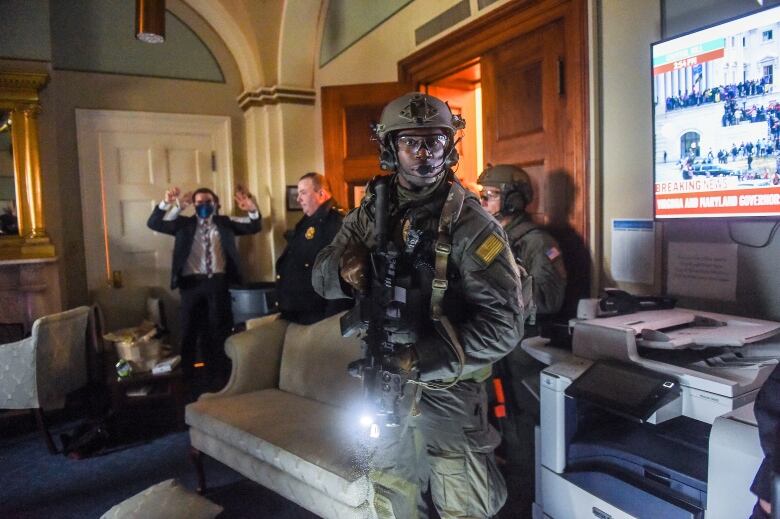4 historic attacks at the U.S. Capitol
Previous attacks made by Puerto Rican nationalists, a homicidal Harvard professor and Vietnam-era radicals
At least one person has died after hundreds of supporters of U.S. President Donald Trump entered the Capitol onWednesday in a bid to overturn his election defeat duringwhat was supposed to be a pro forma joint session of Congress.
A spokespersonfor the Washington police department confirmed a woman had been fatally shot in the chaos that ensued in the early afternoon, though details were scarce as of early Wednesday evening.
While the sceneshave stunned many and led to bipartisan condemnations, the U.S. has seen a handful of other alarming incidents of violence at its Capitol. Perhaps most famously, just 14 years after the building opened, British forces tried to burn it down in 1814. The invaders looted the building first, and then set the southern and northern wings ablaze, incinerating the Library of Congress.
Here are are some other, perhaps lesser known incidents from the past century or so.
Three sticks of dynamite July 2, 1915
Newspapers headlines across the U.S. blaredaboutthe frenzied attack of a suspect identified as aprofessor at Cornell University, Frank Holt, described by the New York Times as "an educator with a reputation among his associates as an easygoing man."
The suspect had smuggled three sticks of dynamite in a suitcase into the Capitol on July 2, 1915.Finding the Senate chamber locked, he settled on an area in the Senate's reception area. The bomb went off hours later, causing damage.
The attacker had sent a letter to a Washington paper under the moniker R. Pearce, expressing opposition to the U.S. selling arms and munitions to Germany's enemies as the First World War progressed.
A day after the D.C. attack the same suspectproceeded to the Long Island home of financier J.P. Morgan Jr., who he pegged as a war profiteer injuring him with two shots before being subdued by Morgan's butler.
Turns out, the man was neither Holt nor Pearce, but Erich Muenter, a German who was a Harvard professor suspected in the poisoning death of his wife in 1906. He had fled to Mexico and returned with an alias.
These were among the events detailed in the 2014 book by Howard Blum, Dark Invasion: 1915: Germany's Secret War and the Hunt for the First Terrorist Cell in America.
Muenter was dead by July 6, 1915, killed by a fall in prison. It was ruled a suicide.
Puerto Rican nationalists attackCongress March 1, 1954
Largely lost from public memory now, the push for nationhood for Puerto Rico and anger at U.S. colonialism spurred attacks on the island and in New York City, all the way up to the Fraunces Tavern bombing in 1975, which killed four people. There was even an assassination plot that targeted then president Harry Truman in 1950.
In 1952, a significant majority of Puerto Ricans voted for commonwealth status but some nationalists were unmoved, calling it a mere faade.
Nationalists Lolita Lebrn, Irvin Flores Rodrguez, Rafael Cancel Miranda and Andres Figueroa Cordero, carried out their attack in D.C., on March 1, 1954, from the gallery of the House of Representatives, wheremembers were debating a bill concerning migrant Mexican workers.

Five congressmen Republicans Alvin Bentley and Ben Jensen, and Democrats Clifford Davis, George Hyde Fallon and Kenneth Roberts were injured by gunfire. Bentley was the most seriously injuredand requirednumerous surgeries, but he returned to work seven weeks later.
At a subsequent trial, Lebrn received a 50-year sentence, while the men received 75 years in prison for attempted murder and other charges.
President Jimmy Carter commuted all foursentences during his presidential term in the late 1970s. According to the administration, theaction was intended as both a "humanitarian gesture to the international community"andto pave the way for the release of four Americansbeing detainedin Cuba.
Bullet holes can still be seen in House chamber from the shooting #OnThisDay 1954. House was debaing federal program allowing migrant Mexican farmers to work in US with Speaker Martin presiding when 5 Congressmen were shot on the floor. https://t.co/pibetZBNUZ @cspanhistory pic.twitter.com/ms4yQHTDo1
—@CraigCaplanCancel Miranda,the last surviving member of the group,died in March 2020. He continued to campaign for the independence of Puerto Rico and participated in marches and demonstrations after his release. In 2016, he told a New York Times reporter,"62 years later I'm not sorry."
Bullet holes from the attack are still present in the chamber to this day.
Bombing in protest of U.S. military in Laos March 1, 1971
The U.S. presence in Vietnam led to a spate of bombings and violent attacks at a host of sites, including U.S. draft board locations as well as corporations, banks and educational institutions seen to be supporting the war effort.
Leftist militants the Weather Underground claimed responsibility for a bomb placed in a men's washroom one floor below the Senate chamber on March 1, 1971.
The group said the bombing was in protest ofthe expansion of the U.S. military presence in Southeast Asia, specifically to Laos. The bomb threat was phoned in overnight, 30 minutes before detonation.
Given the time of day, no one was injured in the blast, but damage was estimated at $300,000 US.

The bombing threatened to derail a peaceful protest planned for Washington in early May and heightened the response from Richard Nixon's administration, events detailed in the recent book by Lawrence Roberts, Mayday 1971: A White House at War, a Revolt in the Streets, and the Untold History of America's Biggest Mass Arrest.
Those protests took place, and with pressure from the Nixon administration, D.C. police arrested 12,000 people, the largest mass arrest in U.S. history.
Civil liberty groups unsurprisingly were appalled, however even some judges assigned to the cases were aggrieved and ultimately only a few dozen were convicted of various offences. Those wrongly detained becameeligible for compensation in civil litigation settlement that followed for years afterward.
While several members of the Weather Underground would serve prison time for other attacks and activities, no one was ever arrested for the 1971 bombing.
As Roberts details, the incident helped spur the installation of video cameras, X-ray machines and regular baggage checks by security staff at the Capitol.
Armed Resistance Unit bombing Nov. 7, 1983
As with the 1971 explosion, a bomb planted just outside the Senate on Nov. 7,1983, did not lead to any casualties, though the Associated Press reported that itblew out a wall, damaged five paintings and blew doors off hingesoutside the office of Senate majority leader Robert Byrd.The estimated damage was $250,000.
The bombing was called in ahead of timebya group identifying itself as the Armed Resistance Unit. The group was protesting U.S. military involvement in Lebanon and Grenada.
Atotal of seven people said to be affiliated with the group, many who identified as Marxists or communists, were arrested beginning in 1985 for the D.C. crimeas well as a Brinks truck robbery and bombings at military installations.

Laura Whitehorn, Linda Evans and Marilyn Buck in 1990 would avoid trial by pleading guilty to charges that included conspiracy and destruction of government property.
According to an Associated Pressrecap of the court hearing, about 50 supporters of the defendants turned out and applauded after the judge recessed the hearing, with the three womenraising their fists in a saluteto their supporters.
Three more people, already in prison for some other offences connected to the group, saw their D.C. charges dropped.Elizabeth Ann Duke, who would be 80 if still alive today, remains a fugitive.
Whitehorn was released on parole in 1999. Days before leaving office in 2001,Bill Clinton commuted Evans's sentence to time served, which amounted to 16 years in prison. Buck was released on compassionate grounds in 2010 shortly before she died of cancer.
As a result of the attack, areas previously open to the public at the Capitol were closed, while additional metal detectors and a system of staff identification cards were instituted.
Though the Armed Resistance Unit bombing was the last actualized attack on the Capitol, the 9/11 commission report detailed the possibility that thehijacked plane piloted by Ziad Jarrahon Sept. 11, 2001, which crashed in Pennsylvania and killedall aboard, could have meant to target the Capitol.
WATCH | How the chaos at the Capitol unfolded:
With files from The Associated Press and Reuters














_(720p).jpg)


 OFFICIAL HD MUSIC VIDEO.jpg)
.jpg)



























































































